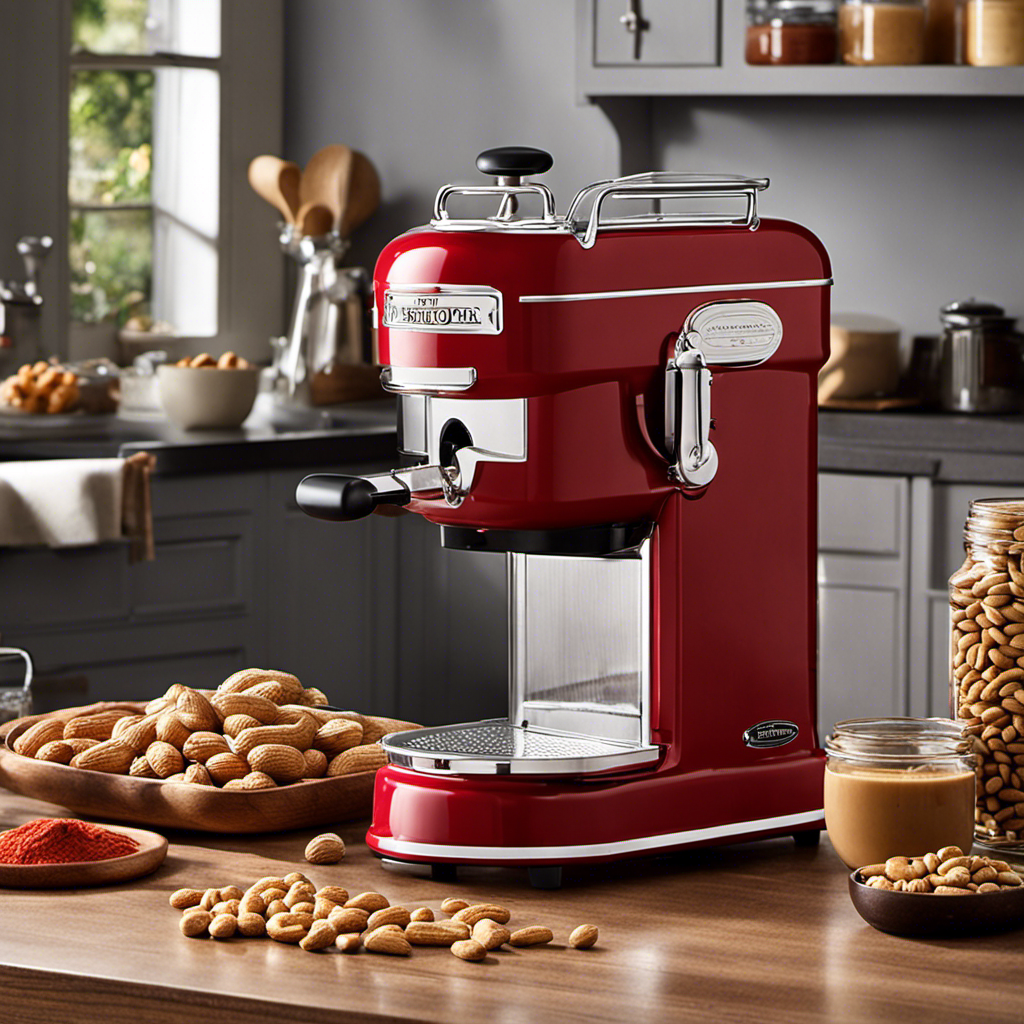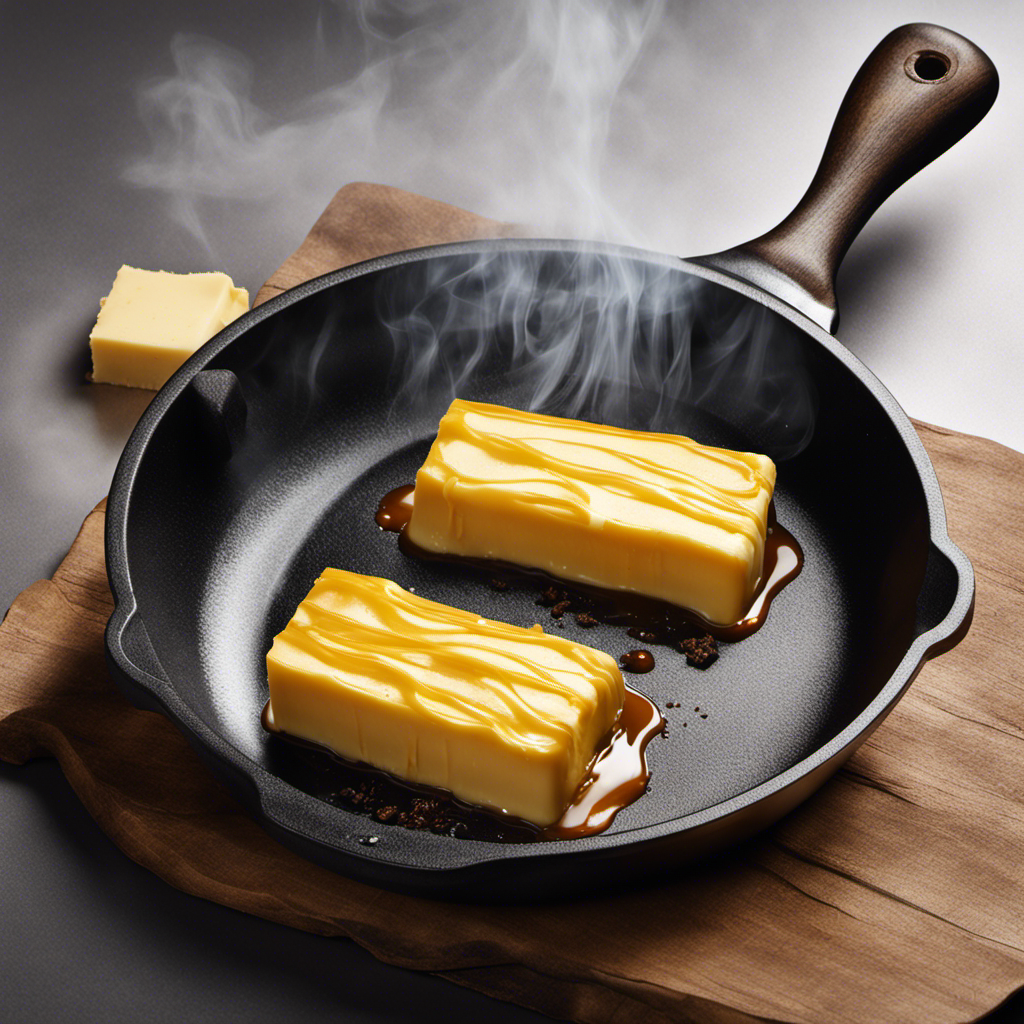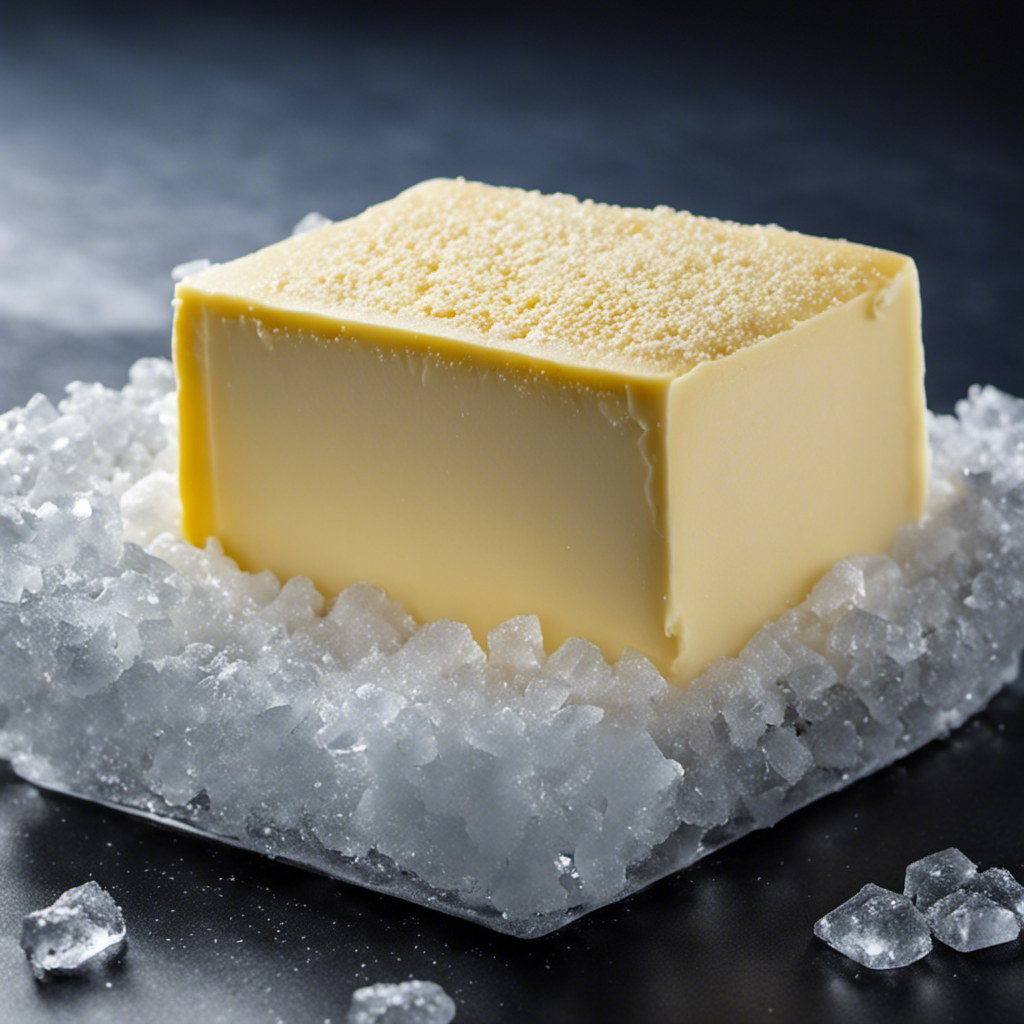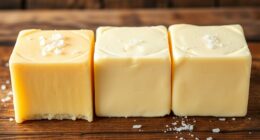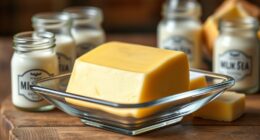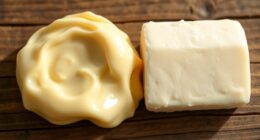Searching for a peanut butter maker? Your search ends here!
In this article, I’ll guide you through the various places where you can find this handy kitchen gadget.
From local kitchen supply stores to online retailers, specialty food shops to farmers markets, and even garage sales and trade shows, there are plenty of options to explore.
Whether you’re a peanut butter enthusiast or simply looking to make your own homemade spread, I’ve got you covered with all the information you need.
Key Takeaways
- There are various places to find peanut butter makers, including local kitchen supply stores, online retailers, specialty food shops, farmers markets, and garage sales/trade shows.
- When choosing where to purchase, factors to consider include the ability to see and touch products before purchasing, the opportunity to support local businesses, convenience of shopping in the neighborhood, wide range of options available online, and lower prices and convenience of doorstep delivery online.
- In finding the best brand, customer reviews, availability of various options both locally and online, easily accessible local options, wider variety of brands and models online, and price and availability are important considerations.
- Department and home appliance stores offer convenience, variety of brands and models, competitive prices and discounts, and consideration of local farmers‘ markets for organic options. Alternative options include secondhand stores, auction websites, local peanut butter makers, social media marketplace groups, and community bulletin boards.
Local Kitchen Supply Stores
You can find a peanut butter maker at local kitchen supply stores. These stores are a great place to start your search for a peanut butter maker because they often carry a wide range of kitchen appliances and gadgets. When looking for a peanut butter maker, it’s important to consider the quality and durability of the machine. Local kitchen supply stores often offer a selection of high-quality peanut butter makers that are built to last.
One of the benefits of purchasing a peanut butter maker from a local kitchen supply store is the opportunity to support local farmers. Many of these stores source their products from local farmers and artisans, which means you can feel good about your purchase knowing that you are supporting local businesses.
In addition to finding peanut butter makers, local kitchen supply stores may also offer homemade options. These homemade options are made by local producers who specialize in creating delicious and nutritious peanut butter. By choosing a homemade option, you can enjoy a unique and flavorful peanut butter that is crafted with care.
Overall, local kitchen supply stores are a convenient and reliable option for finding a peanut butter maker. With their wide selection, support for local farmers, and homemade options, you can find the perfect peanut butter maker to satisfy your cravings for homemade peanut butter.
Online Retailers
There’s a variety of online retailers that sell peanut butter makers. When it comes to finding a peanut butter maker, you have the option of shopping locally at kitchen supply stores or exploring online retailers. Both options have their advantages and disadvantages, so it’s important to consider factors such as price and availability before making a decision.
Online retailers offer a wide range of peanut butter makers to choose from. They provide convenience and the ability to compare prices and read customer reviews. Additionally, online retailers often have a larger selection of products compared to local stores. However, one downside of shopping online is that you can’t physically see or try out the peanut butter maker before purchasing it.
To help you make a decision, I have compiled a table comparing local and online options for peanut butter makers:
| Local Options | Online Options | |
|---|---|---|
| Price | Varies | Competitive |
| Availability | Limited | Wide selection |
| Convenience | Immediate | Delivery |
In terms of price, local options may vary depending on the store and location. However, online options tend to be more competitive, with the ability to find deals and discounts. Availability is another factor to consider. Local stores may have limited stock, while online retailers usually have a wide selection to choose from. Lastly, convenience plays a role. Local options offer immediate access to the product, while online options require delivery time.
When comparing local and online options for peanut butter makers, it ultimately depends on your personal preferences and priorities. If you prefer to see and touch the product before buying, local stores may be the way to go. However, if you value a wide selection and competitive prices, online retailers are worth exploring. Now, let’s move on to the next section and discuss specialty food shops.
Specialty Food Shops
Specialty food shops offer a unique selection of gourmet products for those looking for something beyond the ordinary. These local specialty shops are a treasure trove of culinary delights, filled with homemade options and artisanal treats. Here are three reasons why you should explore these shops:
-
Quality: Local specialty shops take pride in sourcing the finest ingredients and creating products with utmost care. From handcrafted chocolates to small-batch jams, you’ll find a level of quality that is hard to match elsewhere.
-
Variety: These shops offer a wide range of products that cater to different tastes and dietary preferences. Whether you’re searching for organic, gluten-free, or vegan options, there’s something for everyone. You can even find unique flavor combinations that will tantalize your taste buds.
-
Support for local artisans: By shopping at these specialty stores, you directly support local artisans and small businesses. You can feel good about your purchase knowing that you’re contributing to the local economy and helping to keep traditional food-making techniques alive.
As you explore the world of specialty food shops, you’ll discover a whole new world of flavors and culinary experiences. But if you’re looking for an even more immersive experience, then farmers markets are the next stop on your food journey.
Farmers Markets
If you’re craving fresh produce and local goods, farmers markets are where you can find an abundance of farm-fresh fruits, vegetables, and artisanal products. Farmers markets are a great way to support local farmers and businesses while enjoying the best that nature has to offer.
When you visit a farmers market, you’ll be greeted by rows of stalls filled with colorful fruits and vegetables, all grown by local farmers who take pride in their produce.
One of the things I love most about farmers markets is the wide variety of homemade options available. You can find everything from freshly baked bread and pastries to homemade jams and preserves. There are also plenty of artisanal products to choose from, such as locally made cheeses, honey, and pickles. The best part is that you can often sample these products before you buy, ensuring that you’re getting the highest quality goods.
In addition to the delicious food, farmers markets are also a great place to connect with the community. You can chat with the farmers and artisans, learning about their farming practices and the story behind their products. It’s a wonderful opportunity to support local businesses and learn more about where your food comes from.
Health Food Stores
When it comes to shopping for health food, there are two main options to consider: local stores or online platforms.
Local stores offer the advantage of being able to see and touch the products before purchasing, as well as the opportunity to support local businesses.
On the other hand, online platforms provide a wider range of options and the convenience of having the products delivered right to your doorstep.
As for the best brands available, it ultimately depends on personal preferences and dietary needs. However, some reputable brands that consistently rank high in terms of quality and taste include Bob’s Red Mill, Navitas Organics, and Thrive Market.
Local Vs. Online Options
You can easily compare prices and availability of peanut butter makers online and locally. When considering where to purchase a peanut butter maker, it’s important to weigh the pros and cons of both options. Here are some key points to consider:
- Online Options:
- Wide selection: Online retailers offer a vast range of peanut butter makers, allowing you to choose from various brands and models.
- Competitive prices: Online stores often have lower prices compared to local stores due to reduced overhead costs.
- Customer reviews: Online platforms provide access to customer reviews, helping you make an informed decision based on the experiences of others.
Transitioning into the subsequent section about the best brands available, it’s crucial to consider these factors when evaluating which peanut butter maker is the right choice for you.
Best Brands Available
To determine the best brand available, take a look at customer reviews and compare the features and prices. When it comes to peanut butter makers, there are various options available both locally and online. Local options may have the advantage of being easily accessible and allowing you to see the product in person before purchasing. On the other hand, online options provide a wider variety of brands and models to choose from, with the convenience of shopping from the comfort of your own home. Price and availability are important factors to consider when deciding between local and online options. Online retailers often offer competitive prices and have a larger inventory, making it easier to find the specific brand or model you are looking for. Here is a comparison table of three popular peanut butter maker brands:
| Brand | Features | Price |
|---|---|---|
| Brand A | Stainless steel construction, multiple speed options | $99.99 |
| Brand B | BPA-free materials, easy-to-clean design | $79.99 |
| Brand C | Compact size, powerful motor | $129.99 |
Department Stores
If you’re looking for a peanut butter maker, department stores like Walmart or Target may have them in their kitchen appliances section. These stores often have a wide variety of kitchen gadgets and appliances, making it convenient to find the peanut butter maker you’re looking for.
Here are some reasons why department stores can be a great option for finding a peanut butter maker:
-
Convenience: Department stores are easily accessible and can be found in most neighborhoods. You can simply visit the store and browse through their kitchen appliances section to find the peanut butter maker you need.
-
Variety: These stores usually carry a range of brands and models, giving you plenty of options to choose from. You can compare different features, prices, and customer reviews to make an informed decision.
-
Affordable prices: Department stores often offer competitive prices and discounts on kitchen appliances. You may find special deals or promotions that can help you save money on your purchase.
As you explore the options available at department stores, you may also consider checking out local farmers‘ markets for organic options. Local farmers often offer homemade peanut butter made from high-quality, organic ingredients.
Transitioning to the subsequent section about home appliance stores, they can be another great place to find peanut butter makers with a wider range of options.
Home Appliance Stores
When it comes to finding the best store options for home appliances, price and availability are key factors to consider.
As someone who has done extensive research in this area, I can confidently say that there are a few standout options.
From my experience, stores like Best Buy and Home Depot tend to have a wide selection of appliances, competitive prices, and good availability, making them top choices for anyone looking to purchase home appliances.
Best Store Options
You can’t go wrong checking out the local grocery stores for a peanut butter maker. These stores often carry a variety of kitchen appliances, including peanut butter makers, that you can purchase on the spot. Here are some options to consider:
-
Local Grocery Stores: Visit your neighborhood grocery stores such as Walmart, Kroger, or Safeway. They usually have a section dedicated to kitchen appliances where you might find a peanut butter maker.
-
Specialty Food Stores: Check out specialty food stores like Whole Foods or Trader Joe’s. They often carry unique kitchen gadgets, including peanut butter makers, that cater to health-conscious consumers.
-
Online Marketplace Options: Don’t forget the convenience of online shopping! Websites like Amazon or eBay offer a wide selection of peanut butter makers, allowing you to compare prices and read customer reviews before making a purchase.
Whether you prefer the convenience of local grocery stores or the variety of online marketplaces, you have plenty of options to find the perfect peanut butter maker for your needs. Happy shopping!
Price and Availability
Don’t overlook the importance of price and availability when searching for kitchen appliances like peanut butter makers. Whether you prefer local or online options, it’s crucial to consider both factors.
Local stores may provide the advantage of immediate access, allowing you to bring home your peanut butter maker right away. Additionally, you can physically examine the product and seek advice from knowledgeable staff.
On the other hand, online options offer convenience and a wider range of choices. You can easily compare prices and read customer reviews to make an informed decision.
When it comes to the best brands available, some popular options include Cuisinart, Hamilton Beach, and KitchenAid. These brands are known for their quality, durability, and efficient performance.
Secondhand Stores
I’ve heard that secondhand stores sometimes have peanut butter makers. It’s always exciting to stumble upon unique and unexpected treasures while browsing through local thrift shops or flea markets. You never know what you might find!
Here are three reasons why checking out secondhand stores can be a great option for finding a peanut butter maker:
-
Hidden Gems: Secondhand stores are often filled with hidden gems and unique items that you won’t find in regular retail stores. You might come across a vintage peanut butter maker that adds a touch of nostalgia to your kitchen.
-
Affordable Prices: One of the advantages of shopping at secondhand stores is that you can often find items at a fraction of their original cost. This means you can potentially score a peanut butter maker at a much lower price compared to buying it brand new.
-
Sustainable Choice: By purchasing a peanut butter maker from a secondhand store, you are participating in sustainable consumption. Giving a pre-loved item a second life helps reduce waste and promotes a more environmentally friendly lifestyle.
Auction Websites
When it comes to finding rare peanut butter makers, popular auction websites can be a treasure trove. These websites offer a wide range of products, from vintage to contemporary, making it easier to find that unique peanut butter maker you’ve been searching for.
To successfully navigate these auctions, it’s important to have a solid bidding strategy in place and be aware of some useful tips that can help you secure the best deal.
Popular Auction Websites
You can find a peanut butter maker on popular auction websites. These websites provide a wide range of options for finding vintage items, including peanut butter makers.
Here are some tips for navigating these platforms and negotiating prices:
-
Research: Before making a purchase, research the different models and brands of peanut butter makers available. This will help you make an informed decision and have a better idea of what price range to expect.
-
Set a budget: Determine your budget before browsing through the listings. This will help you narrow down your options and focus on the peanut butter makers that fall within your price range.
-
Communicate with sellers: If you find a peanut butter maker that you’re interested in, don’t hesitate to reach out to the seller. Ask questions about the item’s condition, any additional accessories included, and if they are open to negotiating the price.
Finding Rare Peanut Butter Makers
After exploring popular auction websites for peanut butter makers, I realized that finding rare peanut butter makers can be a bit challenging. However, one option worth considering is local peanut butter makers. These are individuals or small businesses who make their own peanut butter from scratch. Not only do they offer unique and high-quality products, but they also often have a deep passion for creating delicious spreads.
To find local peanut butter makers, you can start by searching online directories or local food markets. You may also come across them at community events or farmer’s markets. Engaging with these makers can be an excellent opportunity to learn more about their homemade peanut butter recipes and techniques. They may even be willing to share some of their secrets or provide tips for making your own delicious peanut butter at home.
Bidding Strategies and Tips
One option is to research popular bidding strategies and tips to increase your chances of winning rare items on auction websites. Bidding on rare items can be a thrilling experience, but it requires a strategic approach to come out on top. Here are some effective strategies and tips to help you find and win those elusive rare options:
-
Do your research: Before bidding, thoroughly research the item you are interested in. Look for similar items that have been auctioned before to get an idea of their average price and demand.
-
Set a budget: Determine your maximum bid and stick to it. It’s easy to get caught up in the excitement of bidding, but setting a budget will help you avoid overspending.
-
Time your bids strategically: Place your bids strategically, considering the timing of the auction’s end. Bidding in the final seconds can catch others off guard and increase your chances of winning.
Social Media Marketplace Groups
There’s a great place to find a peanut butter maker in social media marketplace groups. These groups are a treasure trove of bargains and deals on all sorts of items, including kitchen appliances like peanut butter makers. If you’re looking to save some money and find a quality peanut butter maker, these marketplace groups are the way to go.
When it comes to bargaining techniques and seller negotiation strategies in these groups, there are a few key things to keep in mind. First, always do your research before making an offer. Know the average price of the item you’re interested in and be prepared to negotiate based on that information.
Second, be polite and respectful when interacting with sellers. Remember, they are under no obligation to accept your offer, so being kind and understanding can go a long way in securing a good deal. Additionally, offering to pay in cash or being flexible with pick-up times can also help sway a seller in your favor.
Lastly, don’t be afraid to walk away if the price isn’t right. There are often multiple sellers offering the same item, so if one seller isn’t willing to negotiate, you can always try your luck with another. With a little patience and persistence, you’re sure to find a great peanut butter maker at a price that suits your budget.
Community Bulletin Boards
If you’re looking for local events and announcements, community bulletin boards are a great resource to check out. They are often found in public spaces such as libraries, community centers, and grocery stores. Here’s why I think they are worth exploring:
-
Local Community Groups: Bulletin boards are a hub for local community groups to share information about their events and activities. Whether it’s a neighborhood cleanup day or a fundraising event, these boards are a go-to place to find out what’s happening in your area.
-
Word of Mouth Recommendations: One of the great things about bulletin boards is that they often contain recommendations from community members. People might post about a great local restaurant, a reliable handyman, or a fun workshop they attended. These personal recommendations can be invaluable when you’re looking for trusted services or experiences.
-
Varied Content: Bulletin boards offer a diverse range of content. You might find flyers for upcoming art exhibitions, job postings, volunteer opportunities, or even local garage sales. It’s like a curated collection of what’s happening in your community.
Garage Sales
When you’re looking for some hidden treasures and great deals, checking out local garage sales can be a fantastic way to spend your weekend. Garage sales are like hidden gems waiting to be discovered. You never know what you might find, from vintage clothing to antique furniture to rare collectibles.
The key to finding garage sale bargains is to be prepared and have a strategy in place. First, it’s important to do some research beforehand. Look for garage sales in your area by checking local classifieds, online listings, or community bulletin boards. Plan your route to maximize your time and cover as many sales as possible.
When you arrive at a garage sale, be sure to arrive early to get first dibs on the best items. Once you’re at the sale, take your time and thoroughly inspect the items. Look for quality pieces that are in good condition. Don’t be afraid to negotiate prices with the sellers, as they are usually willing to haggle. Keep in mind that some of the best deals can be found towards the end of the sale when sellers are more willing to lower their prices.
Trade Shows
Attending trade shows provides valuable networking opportunities for manufacturers. It allows them to connect with industry professionals, potential customers, and suppliers. These events offer a platform for showcasing new product innovations and gaining valuable feedback from a diverse audience.
Networking Opportunities for Manufacturers
There’s plenty of opportunities for manufacturers to network and connect with other professionals in the industry. Networking events and industry conferences are great platforms to meet like-minded individuals, exchange ideas, and explore potential collaborations.
Here are some benefits of attending these events:
-
Expand Your Network: Networking events provide a chance to meet a diverse range of professionals, from suppliers to distributors and potential customers. Building relationships can lead to new business opportunities and partnerships.
-
Stay Updated: Industry conferences often feature keynote speakers and informative sessions that keep you up-to-date with the latest trends, technologies, and market insights. This knowledge can help you stay competitive in the ever-evolving manufacturing landscape.
-
Learn from Peers: These events offer a valuable opportunity to learn from experienced professionals who have faced similar challenges. Engaging in conversations and sharing best practices can help you overcome obstacles and improve your business strategies.
Attending networking events and industry conferences can significantly enhance your professional growth and open doors to new possibilities.
Showcase New Product Innovations
Take advantage of networking events and industry conferences to showcase your new product innovations and gain valuable feedback from industry professionals. These events provide a platform for you to demonstrate the unique features and benefits of your products, as well as build relationships with potential customers and partners. By showcasing your innovations at these events, you can create buzz and generate interest in your products, leading to increased sales and market visibility.
In addition to networking events, it is also important to consider the local vs. online marketplaces when showcasing your new product innovations. While online marketplaces offer a wide reach and convenience, buying from local stores has its own set of benefits. These include the ability to see and touch the product before purchasing, supporting local businesses and the local economy, and the opportunity to receive personalized customer service. By leveraging both local and online marketplaces, you can maximize your product exposure and reach a diverse customer base.
Consider the following table that highlights the benefits of buying from local stores:
| Benefits of Buying from Local Stores |
|---|
| Ability to see and touch the product before purchasing |
| Support local businesses and the local economy |
| Opportunity to receive personalized customer service |
| Build relationships with local store owners and staff |
Manufacturer Websites
You can find a peanut butter maker on manufacturer websites. When it comes to purchasing a peanut butter maker, there are two main options to consider – local vs. online.
While local options may provide the convenience of immediate access and the ability to see the product in person, online options offer a wider selection and the convenience of shopping from the comfort of your own home.
Here are some of the best brands available:
-
KitchenAid: Known for their high-quality kitchen appliances, KitchenAid offers a peanut butter maker that is durable and efficient. Their models come with various features such as adjustable settings and easy-to-clean components.
-
Cuisinart: Cuisinart is another reputable brand that offers a range of peanut butter makers. Their models are designed to be user-friendly, with features like automatic mixing and grinding functions.
-
Hamilton Beach: Hamilton Beach is a popular brand that offers affordable and reliable peanut butter makers. Their models are known for their simplicity and ease of use, making them perfect for beginners.
DIY Websites and Blogs
DIY websites and blogs offer a multitude of resources for those looking to create homemade products. When it comes to kitchen gadgets, there are plenty of DIY options available that can help you make your own peanut butter. Homemade peanut butter is not only healthier, but it also allows you to customize the flavor and texture according to your preferences.
One popular DIY kitchen gadget for making peanut butter is a food processor. With a food processor, you can easily grind roasted peanuts into a smooth and creamy butter. Many DIY websites and blogs provide step-by-step instructions on how to use a food processor to make peanut butter, along with variations such as adding honey or cinnamon for a unique twist.
Another popular option is a blender. While a blender may not give you the same smooth consistency as a food processor, it can still get the job done. DIY websites and blogs often offer tips on how to use a blender to make peanut butter, including adding oil or sweeteners to enhance the flavor.
In addition to the kitchen gadgets, DIY websites and blogs also provide a plethora of homemade peanut butter recipes. From classic peanut butter to creative variations like chocolate peanut butter or almond butter, you can find a recipe to suit your taste. These websites and blogs also offer tips on storing homemade peanut butter and using it in different recipes.
Frequently Asked Questions
What Are the Different Types of Peanut Butter Makers Available in the Market?
There are various brands of peanut butter makers available in the market. Homemade peanut butter has its pros and cons. It’s important to consider factors like price, ease of use, and maintenance when choosing one.
How Much Does a Peanut Butter Maker Typically Cost?
Typically, the cost of a peanut butter maker varies depending on the brand and features. However, making homemade peanut butter has many benefits, including cost savings and the ability to control the ingredients.
Are There Any Specific Features to Look for When Purchasing a Peanut Butter Maker?
When purchasing a peanut butter maker, it’s important to consider the specific features. Pros include customization and freshness, but cons include the cost and time required for cleaning. There are also different ways to use homemade peanut butter, like in smoothies or baking.
Can a Peanut Butter Maker Be Used for Other Nuts or Seeds?
Yes, a peanut butter maker can be used for almonds or cashews. To clean it effectively, first disassemble the parts and wash them with warm soapy water. Then, dry them thoroughly before reassembling.
What Is the Average Lifespan of a Peanut Butter Maker?
The average lifespan of a peanut butter maker depends on its maintenance requirements. Regular cleaning and proper use can extend its life. It’s important to follow the manufacturer’s instructions for best results.
Conclusion
Well, it seems that my quest for a peanut butter maker has taken me to some unexpected places. Who knew that local kitchen supply stores, online retailers, and specialty food shops would all have the power to satisfy my nutty desires?
And who could have predicted that farmers markets, health food stores, and even garage sales would offer up the holy grail of peanut butter making? It just goes to show that when it comes to finding the perfect peanut butter maker, you never know where you might stumble upon your nutty treasure.
So keep your eyes peeled and your taste buds ready, because the world of peanut butter making is full of surprises.
